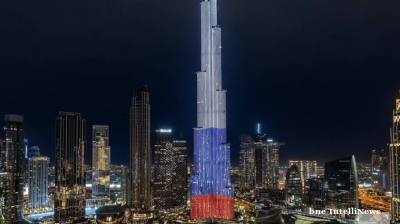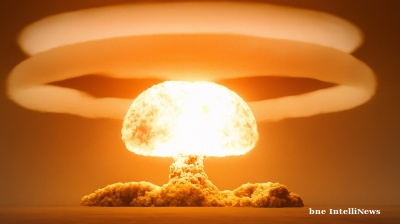Russia’s economy defied all expectations in 2023 by not only not collapsing but by being the fastest growing country in Europe by the end of 2023.
The economy in 2023 surpassed its 2021 levels, with GDP registering notable increases. In October alone, GDP exhibited a year-on-year growth of 5% in November following 5.6% growth in September, according to official figures.
Independent assessments from Bloomberg Economics echo these figures. Their analysis suggests that an annual growth rate of 5-5.5% in the total output of non-financial sectors during the fourth quarter is indicative of an overall economic growth rate of 3-3.5% for the entire year, ahead of the official forecast for 2.2% growth for 2023.
“All is not well with the Russian economy and the sanctions imposed by the West after Russia’s full-scale invasion of Ukraine are working – just not as fast as Western politicians would like. The Russian economy is gradually returning to what it looked like in the late Soviet period or even NEP (New Economic Policy) in 1920s: while the consumer market was dominated by private enterprise, almost everything else – including foreign trade – was largely controlled and calibrated by a Kremlin seeking to boost defence output and ensure social stability,” says Alexandra Prokopenko, a political economy analyst.
Overheating will cause problems in 2024, but won’t cripple the government. The Kremlin has used up all the slack in the economy. There are no more reserves to increase supply in the economy. Therefore growing demand will only lead to higher prices. And overheating may lead to unrealistic optimism – on behalf of households and companies – about future income prospects, resulting in more borrowing. Such a trend is already visible in the mortgage sector.
“Production increases will be limited by sanctions, even if Russia and Ukraine confound expectations and enter peace talks. It’s unlikely there will be any major fiscal problems before the end of next year, but the risks of such a scenario will increase over time,” says Prokopenko.
The rapid economic growth in 2023 was fuelled by a record RUB32 trillion ($346bn) of state spending, much of which went on defence. Industrial output grew 3.6%; manufacturing expanded at 7.5%, and military-linked production expanded at double-digit rates. And in 2024, spending will only rise again, superheating an already hot economy: spending is planned to be RUB36.5 trillion ($395bn), more than a third of which will go on the defence sector and various wartime payments.
It’s not the first time in recent Russian history that the government has resorted to large-scale economic stimulus. For example, during the Covid pandemic, anti-crisis aid was worth 2.7% of GDP; but in 2022-23 it was significantly larger – according to official Finance Ministry figures, it was equivalent to some 10% of GDP.
The military Keynesianism boost from putting Russia on a war footing paid dividends that saw industrial production and the PMIs soar. The manufacturing sector, marked by a robust 9.5% growth in October, continues to be driven by the "special military operation," which has contributed to the expansion of industries such as engineering, chemistry and metallurgy.
Investment activity during the third quarter exceeded expectations, also driven by the war, recording an impressive 13.3% growth rate (compared with 10% from January to October).
The labour shortage caused by the draft led to all-time low unemployment that pushed up both nominal and real wages and that in turn fuelled consumption and more growth. At street level Russia appeared to be booming to most Russians.
A surge in consumer and investment demand has been instrumental in boosting wholesale trade. In October, the total consumer spending of citizens exhibited a remarkable y/y increase of 10.7% (and a 3.3% rise compared to October 2021).
In addition, the external situation rapidly improved as the Kremlin quickly found ways to almost entirely dodge sanctions. Both the oil and technology sanctions have almost completely failed. The oil price cap sanctions that were imposed around the start of 2023 have also failed, with the Financial Times reporting that not a single barrel of Russian oil was sold at below the $60 cap.
The two main unknowns in 2024 are how the military situation in Ukraine will unfold, and possible political changes after the re-election of Putin in March. Military experts say that 2024 could be a good one for Russia’s forces, not least because the Kremlin feels increasingly confident that the fighting is going in its favour and at the same time Ukraine is facing a possible financial crisis as essential Western aid dries up.
Multipolar world is here
And on the political front, the Kremlin made good progress with building up support in the non-aligned world, as was manifested in the G20 and BRICS summits in August. What is appearing is not an us-vs-them world, but a fractured world where most of the global south is not on board with the sanctions and happy to accept discounted Russian raw materials and military tech. And Russian President Vladimir Putin is quite happy with that. It was more or less what he had in mind when he launched his campaign to force his multipolar world on the West.
The West overestimated its ability to make sanctions work and has undermined its authority as a result of trying. The upshot is that the multipolar world is here but works a lot less well than the globalised version prior to the pandemic. Global growth is slowing dramatically as a result and that is likely to persist for many years as the new fragmented supercycle begins.
Ukraine fatigue became palpable in the summer as Kyiv’s much vaunted counter-offensive failed to make a spectacular breakthrough, or indeed any measurable progress whatsoever. By the end of the year commentators began to say that a Russian victory was in sight. We finished 2023 without either the $61bn US finance package or the EU four-year €50bn programme in place. Ukraine is running out of money again and could be forced to capitulate in the summer of 2024 if it runs out of ammo. However, given the amount of political capital Western countries have invested into supporting Ukraine it is likely some sort of fudge will be found. For their part, the Ukrainians are determined to fight to the bitter end.
Overheating
Nevertheless, there are problems. Russia’s growth potential has been reduced from 1-2% pre-war to around 0.3-0.5% now and is doomed to stagnation in the long term. With the economy expected to end 2023 with 2.2% growth or more, it is clearly overheating, which is worrying CBR Governor Elvia Nabiullina but not Putin.
This heat is manifested in strongly rising inflation, which is the main economic problem the country faces. The CBR has been hiking rates aggressively, which will start to bite in 2024. The "Cold Calculation" Telegram channel predicts that GDP growth will decelerate to 0.7% in 2024 as the structural problems such as rising inflation and a very tight labour market start to make themselves felt. The zenith of growth is predicted to occur in the fourth quarter of 2024.
But Russia has enough cash in reserves to last at three years or more and Putin’s calculation is that he can win the war with Ukraine well before that, when the economy can be repaired, and the distortions imposed by military spending will end.
CBR rate hikes
While central banks in the West were gearing up to initiate interest rate cuts on the back of a pan-regional fall in inflation, Russia hiked its prime rate by 100bp for the fourth time in 2023 to 16% on December 14 – one point higher than those in war-torn Ukraine.
Inflation remains Russia’s major economic headache that will slow the economy in 2024. However, stepping back and inflation is the only serious problem, as all the other indicators are healthy and the war has little effect on the average Russian’s daily life.
During the December rate hike press conference Nabiullina struck a pessimistic tone. She likened the Russian economy to a car driving too fast: "It can go, it might even be quick, but not for long," she cautioned.
“Think of the economy as an automobile,” Nabiullina said. “If we try to drive it faster than it can go, and pump the gas as hard as we can, sooner or later the engine will burn out and we won’t get far,” the ultra-conservative central banker said.
The CBR predicts that the 2023 inflation in Russia will hover around 7.5%, hitting the upper limit of the Central Bank's projected range. Russian President Vladimir Putin suggested it might even approach 8% in his annual “meet the people” press conference the same week.
Over the last four months of 2023 core inflation surged over 10% in annualised terms, with Nabiullina citing the service sector as an example, experiencing a 14% inflation spike in three months to December, despite minimal impact from the exchange rate and other one-off factors.
This economic overheating is attributed to an inability to meet surging demand, with recent figures revealing that GDP growth is causing a more significant imbalance than anticipated by the Central Bank.
When the Central Bank hiked rates in both 2014-2015, and in early 2022 after the invasion of Ukraine, it was quick to bring them down again once the immediate crisis had passed. This time, however, high rates are here to stay, Nabiullina told journalists. She emphasised that the current high inflation is a systemic problem – and not linked to exchange rate fluctuation, or other one-off factors.
Key points highlighted by Nabiullina include:
Inflation: persistence of high inflationary pressure, with an expected slowdown next year and a goal to bring inflation down to 4% by the end of 2024.
Growth: Despite higher-than-expected GDP growth of 5.5% in the third quarter, the CBR anticipates that sustained growth at this level is unsustainable, projecting GDP growth between 0.5% and 1.5% for next year.
Unemployment: November witnessed unemployment dipping to a record low of 2.9%, prompting companies to focus on maximising staff
productivity, often extending working hours or adding extra shifts.
Subsidised lending: State-subsidised lending, particularly in mortgages, continues to contribute to inflation, with 80% of new mortgages last month being subsidised.
Commodities: The global economy's cooling has resulted in reduced demand for raw materials, affecting Russian oil and gas exports.
Notably absent from Nabiullina's press conference comments was any discussion of the primary cause of Russia's overheating economy: the war in Ukraine and the subsequent substantial increase in military spending, set to rise by 68% in 2024.
There is a growing split between the problems that Nabiullina worries about and the Kremlin, which used the same numbers, but Putin cited them as progress, not a problem, during his annual Q&A session in December.
Economic growth of 5.5% in the third quarter of 2023 means Russia has reversed the previous year’s contraction. “It’s a good indication,” Putin said. By the end of the year, Putin said he expected inflation to be as high as 8%. “Unfortunately we have rising inflation,” he admitted. But he assured viewers that the Central Bank and the government were taking the necessary measures, and that inflation is anticipated to return to target levels.
Industrial output is growing (3.6%), “I’m especially pleased” with 7.5% growth in manufacturing, Putin said (this figure reflects Russia’s booming defence industry). Salaries are up 8%, disposable incomes are up 5% and unemployment is at an all-time low of 2.9%.
“This is a very good integrated indication of the health of the economy,” Putin said.
He is right insomuch as the Russian economy has adapted well to the war demands he is demanding of it: to support the war in Ukraine without damaging standards of living. This approach will inevitably have a whole raft of serious consequences further down the road, but in the short term, Russia’s economy is easily outperforming Ukraine’s and producing the materiel needed for the war without cutting into the country’s standard of living.
It is also easily outperforming the bulk of Europe’s economies, which are all going into recession as a result of the combined problems of the polycrisis and extra costs – both direct and indirect – that supporting Ukraine has imposed on the EU, The sanctions have reached a point where a boomerang effect has kicked in, where they are hurting Europe more than they hurt Russia.
If the war comes to an end within the next two years, then Russia is well placed to recover quickly. However, long term the sanctions, which will remain in place for the foreseeable future, will doom Russia to stagnation.
Just register and you will automatically be sent the e-reader and pdf report.
Any questions or technical problems contact sales@intellinews.com
Features

CEE needs a new growth model as FDI plunges
wiiw economist Richard Grieveson says the CEE region’s long-standing model of attracting FDI through low labour costs no longer works.
KSE: Ukraine is facing a $53bn budget shortfall, but economy is stable for now
Ukraine is in urgent need of additional financing from partners as the continuation of the war drives up defence spending and reconstruction needs, jeopardizes budget financing, weighs on the balance of payments, and slows economic growth.

PANNIER: Ruling family’s ‘palace in the sky’ cruel sight for Turkmenistan’s poor souls down below
Photos posted of renovated Boeing by US makeover manager offer further insight into "ultra-luxurious" world enjoyed by Berdimuhamedovs.

Russia tax service targets Russian accounts in UAE
The Russian Federal Tax Service (FTS) has ramped up its scrutiny of Russian nationals holding accounts in the United Arab Emirates, following the effective implementation of automatic tax information exchange between the two countries.




